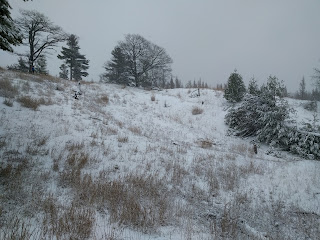This past week I was working on Long Point doing ground-truth surveys of stands of Common Reed (Phragmites australis). I wrote a post about similar work in Big Creek Marsh last February. The week was full of many ups (spending a week hiking around quiet dunes and marshes) and a few downs (equipment breaking and falling through thin ice on the regular). It seemed that after huffing my way up to the high point of a ridge, a photo and sip of water was a good way to catch my breath. Here are some photos from the week!
Snow-blanketed stands of Indian Grass with Red Oak and White Pine lining the ridges. Snow depth wasn't an issue and the snowshoes sat idle at the cabin for the week. By yesterday morning only small patches of snow held on in the shadows of trees while the exposed sands soaked up the warm temperatures.
At every turn you get an appreciation for how dynamic the dune ecosystems at long point are.
Common Bog Arrow-grass (Triglochin maritima)
Swamp Rose (Rosa palustris) formed thickets in some swales. Ontario has 5 native rose species, most of the others tend to be found in more upland habitats. Swamp Rose owes me a new pair of snow pants and a box of band aids!
In some of the areas of open dune small colonies of Bearberry (Arctostaphylos uva-ursi) sprawl across the sand.
At the edge of a marshy depression some green leaves caught my eye. Crushed up they were fragrant, kind of resembling Sheep Laurel (Kalmia angustifolia). From what I can gather I think this shoulder-high shrub is Mezer's Daphne (Daphne mezereum); a non-native species but a very interesting one nonetheless. The serrations on the leaf margins are making me question this ID but for now that's all I can come up with.
In Greek mythology Daphne went to Aphrodite to save her from a lustful god; Aphrodite in turn transformed her into a tree. The shrub has attractive bright pink blooms in spring and produces bright red berries that resemble currants. The plant is highly toxic as it contains mezerein. The Poison Garden website notes that Daphne was actually used in cosmetics as rouge until it was understood that the rosy glow it could give the skin was due to damage it inflicted upon the blood vessels when applied topically. In high doses it causes shivering, dilated pupils, and damage to the oral passage and intestines, nasty stuff!
A shot of a twig.
Through my volunteer work with the Waterloo Stewardship Network we are arranging a prescribed burn to steward a site here in Waterloo Region that has the only known population of Canada Milkvetch (Astragalus canadensis). At Long Point, there are populations of hundreds of plants among the Eastern Cottonwoods along the shores.
Walking through some of the seasonally-flooded swales, the low-growing Variegated Scouring-rush (Equisetum variegatum) is crispy sounding underfoot.
A few microscope photos to show the detail on these tiny fern allies. The third is Scouring-rush (E. hyemale).
This photo shows the differing forms that White Pine can take as trees age and face the elements; the larger tree on the left looks nothing like those in the right side of the photo.
Short-liguled Beach Grass (Ammophila breviligulata) plays a major role in dune formation. This grass is the first 'obstacle' to cause mobile grains of sand to drop and settle on the windward side of a dune. I'm looking forward to a project I'll be working on in Port Stanley this spring that will involve the creation of a small dune area through the installation of snow fence and plugs of Beach Grass and Switchgrass.
I found that the landscapes of the point make for some interesting panorama shots. The first photo is the south beach upon arriving on February 15. On the clear days Pennsylvania and Ohio could easily be seen. By February 20, with the warmer weather and high winds the night before, the pack ice had receded right up to the beach with 1-2m waves. Looking out the cabin window Saturday morning, the iced-over Gravelly Bay had transformed into open waters hosting tonnes of gulls, ducks and swans.
One of the marsh sloughs full of cattails, sedges and rushes.
Duncan's Pond, which outlets into the inner bay of Long Point.
From another vantage point high up on a dune (eek, Phragmites, what a shame).
Wildlife for the week included plenty of signs of White-tailed Deer and Coyote. Bird highlights included Tundra Swan flyovers, a couple of Northern Harriers scanning the sedge meadows for rodents, 3 Bald Eagles, flocks of Pine Siskins, a Turkey Vulture on the ATV drive in and 3 Sandhill Cranes on the drive out.






















No comments:
Post a Comment